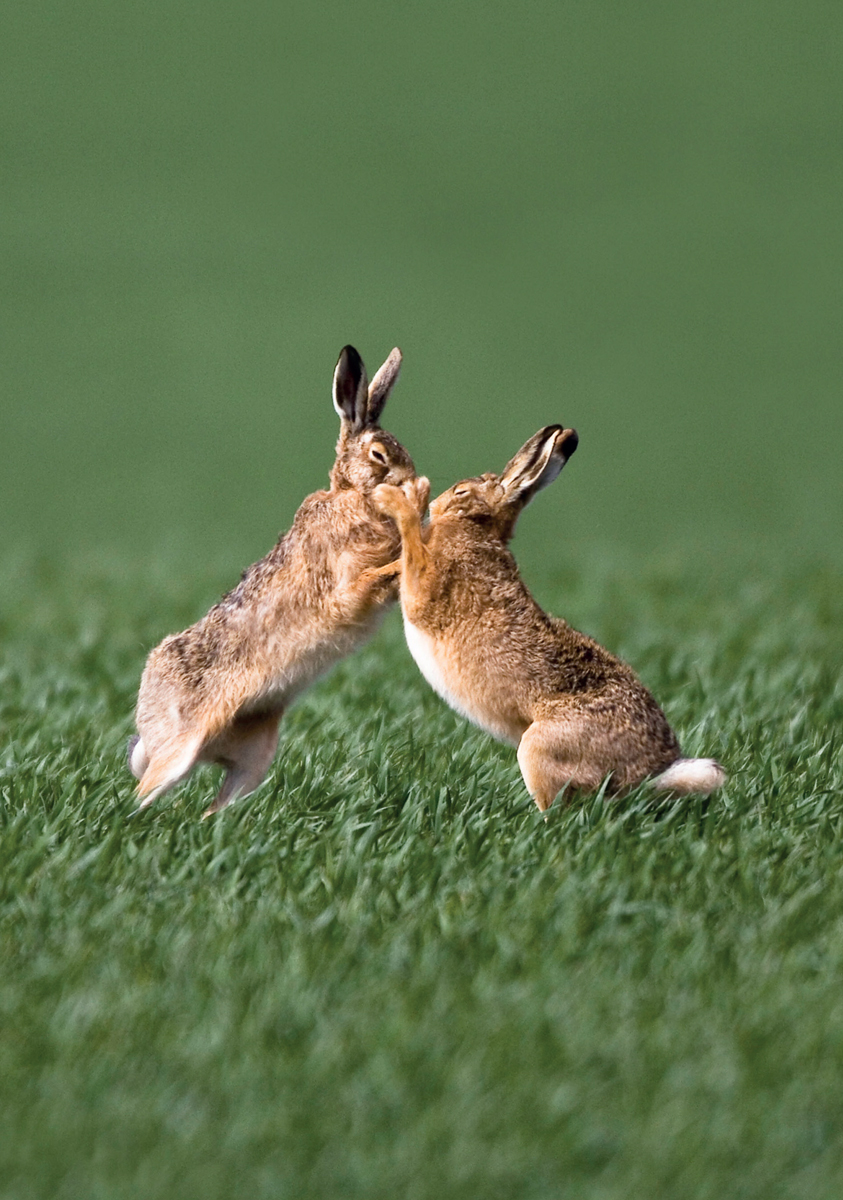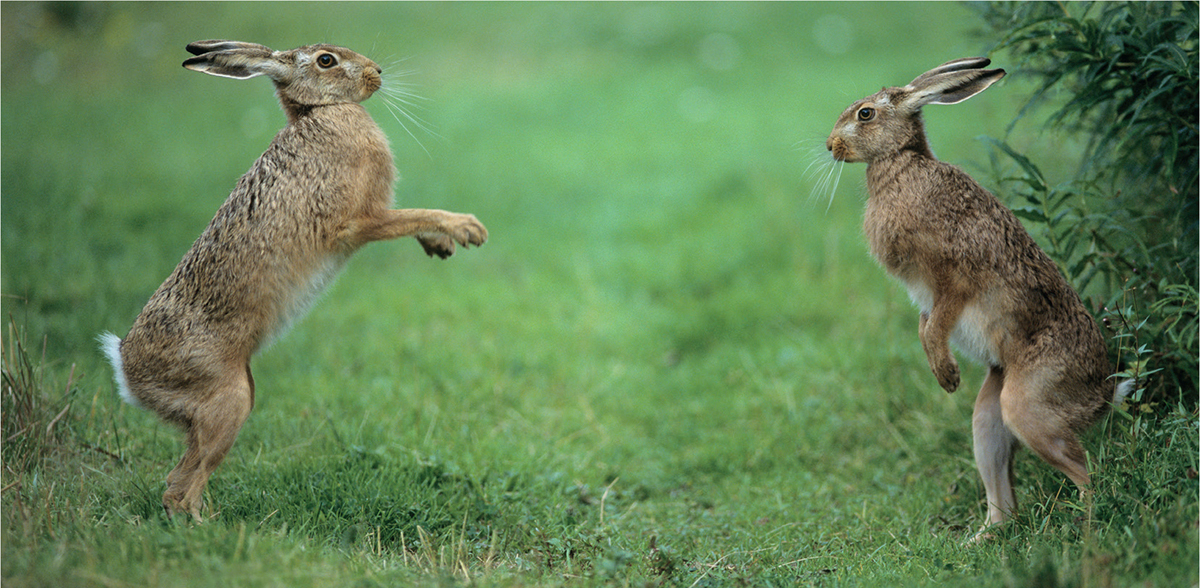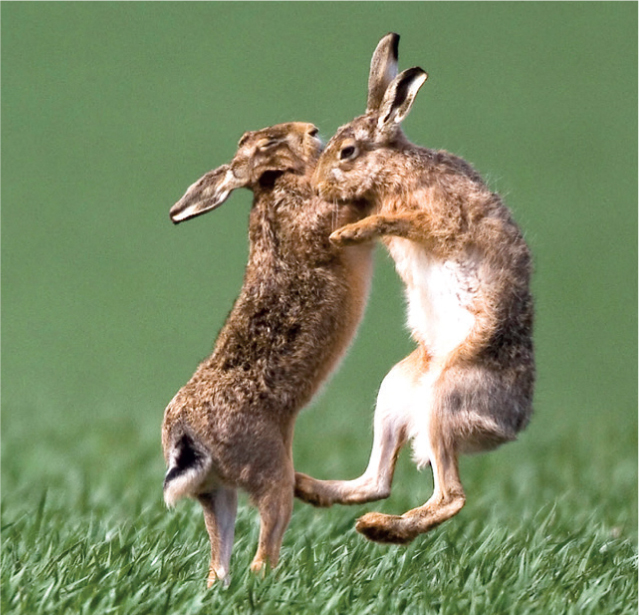
Brown Hares boxing. Females box males when they are not yet ready to mate, both to assess their strength and to chase them away.

Brown Hares boxing. Females box males when they are not yet ready to mate, both to assess their strength and to chase them away.
Breeding Machines
In winter in the northern hemisphere, while the days are short, changes start to take place inside the bodies of hares. Mating begins, and then for several months females are pregnant, suckling young, or both, while males are trying to find mates. The breeding season is a busy one for hares.
In winter, changes in day length act on the pineal gland in the brain and cause changes in the levels of a hormone, melatonin, that is only produced in darkness. Altered levels of melatonin in the blood act on male hares’ genitals. The testicles enlarge, descend from the body cavity into the scrotum, and start to produce sperm, usually in December in male Brown Hares in England. In females, the uterus becomes ready for implantation of embryos around mid-January. Males start to sniff out females, and may follow them for hours, using scent to track them. Sometimes several males follow a single female.
If a male gets too close to a female before she is ready to mate, she strikes at him with her paws, boxing him away and testing his strength to evaluate him as a potential mate. In late December or January, females start to allow males to mate with them, and become pregnant with the first litter of the year.

Hares have a keen sense of smell and use scent to identify other hares and to assess their interest in mating.
Busy breeding seasons
The mating season for Brown Hares in England is roughly January to September. Pregnant females are found in all months from January to August, and fertile males in all months except October and November. The breeding season for Mountain Hares in Scotland is shorter: males are fertile from January to June, and females are pregnant mainly from February to July or August. The gestation period in Mountain Hares is 50 days, as opposed to 41–42 days in Brown Hares. The longer gestation combined with a shorter breeding season and smaller litter size means that Mountain Hare mothers produce fewer leverets each year (circa six) than Brown Hares (10 in Europe). Mountain Hares have two or three litters each year (counted in Sweden), while Brown Hares have three to five.
In the northern hemisphere, a Brown Hare’s first litter of the year is usually small – one, two or, occasionally three leverets – and is often born in February. Within a few hours of giving birth a female hare is ready to mate again, and if she finds a mate she may be pregnant and suckling her young at the same time for four weeks or so. In fact, she is likely to be pregnant, suckling, or both all summer until September. By March and April in England, female Brown Hares tend to be pregnant with bigger litters (three or more leverets). The biggest recorded litter of Brown Hares is 12 leverets. By the end of our summer (August), the last litter of the year is often small again.

Male hares fight to establish a hierarchy, but boxing is most likely to happen when a female wants to show a male that she is not ready or willing to mate. She can test him at the same time. In this case the boxing is between two Scottish Mountain Hares.
Preparing to breed

Against a snowy backdrop, well camouflaged Scottish Mountain Hares mate. It is early spring, the snow will soon start to melt, and this female is starting to get her summer brown coat.
In male Brown Hares, a mating hierarchy is established by biting and chasing. Once the hierarchy exists, there is little need for fighting between males. Like many mammals, hares use scent to identify themselves and others. Males rub their chins on vegetation in order to leave behind their own scent (from special glands). They also urinate on their feet and kick backwards to spread the smell, and lift their tails to release scent from glands. The bossiest males have access to the best food and guard females that are about to become ready to mate, keeping other males away. Male Scottish Mountain Hares are not known to guard potential mates, but dominant male Brown Hares stay within about 5m (16ft) of their target female, day and night. Dominant males are able to mate with more females and father more young than subordinate ones.

Male Brown Hares guard a potential mate for several days before she is ready to mate, on the day that her eggs can be fertilised.
Female Brown Hares may be followed around by one or more males for up to five days before they are ready to mate. When they are nearly ready, they inform the males by shaking their tails and spreading a special scent. They allow males to mate with them only on the one day that their eggs can be fertilised. If they are not ready to mate, females turn away from males, drop their ears in a threatening posture, or box males that approach them closely.
The mad March hare – fact or myth?
Brown Hares have a long breeding season, so the popular belief that males in particular ‘go mad’ in March, fighting and chasing each other, seems strange. Why March, when male hares are fertile in other months? For many years, researchers have disagreed about this.
G. A. Lincoln, working in East Anglia in eastern England in the 1970s, believed that ‘March madness’ represented fights over females between testosterone-fuelled rutting male hares. He calculated that only 16 per cent of young hares were conceived during the period of ‘March madness’, and realised that Brown Hares have a long breeding season – most young are conceived in May, June and July. But he believed that males had high levels of testosterone in March, and that their fighting behaviour stimulated the females into breeding activity at the start of the season.

Hares don’t just ‘go mad’ in March. Brown Hares can be seen boxing throughout their long breeding season.
Tony Holley, watching Brown Hares in south-west England, saw that boxing actually occurs throughout the breeding season from February to September, but when the vegetation gets high and nights get longer this behaviour becomes harder to observe, hence boxing is most often seen in March. Tony also observed that almost all boxing takes place not between rival males, but between a female and a male. Female Brown Hares are slightly bigger than males and, by boxing, are quite capable of showing they are not ready or willing to mate.

Boxing hares are quite aggressive – fur can fly.
John Flux, researching hares in New Zealand used different terminology. He defined ‘boxing’ as fights between males to establish their hierarchy, and ‘rebuffing’ as females pushing males away when they are unwilling to mate. Like Lincoln, he believed that testosterone levels in males peak in March in the northern hemisphere (equivalent to September in New Zealand), and that males are aggressive at this time. He suggested that boxing (between males) is less common in populations in which the males all know each other and know their place in the hierarchy.
The jury is still out on the ‘mad March hare’, though it is clear that boxing has something to do with mating.
Boy or girl, old or young?
Male hares are called ‘bucks’ or ‘jacks’, females are called ‘does’ or ‘jills’. There are many ways people claim to ‘know’ the sex of hares seen in the field. Some believe only females trail their ears behind them when running, others claim only males do that. Some people think only females run back through the line of beaters during hunting. Some think only males box, while others believe males and females ‘flush’ from their forms at different distances. The list goes on.
In fact, it is not easy to tell the sexes apart even when you have a dead hare in your hands, but it can be done by carefully examining the genitals. There is no truth in any of the claims above: male and female hares look very similar, and behave mostly in the same way. So, unless you are lucky enough to observe suckling, copulation or courtship, it is hard to tell the bucks from the does.
It is also far from easy to work out how old hares are. Pliny the Elder quotes the ancient Greek philosopher Archelaus as saying that a ‘hare is as many years old as it has folds in the bowel’, and also that hares are hermaphrodites. Both these claims are also, of course, untrue. Young hares are tricky to identify once they approach adult weight, but biologists use various methods. The eye lenses of mammals continue to grow throughout their life, so the dry weight of the lenses can be used to work out the age of a hare. Extremely accurate scales are needed though – the eye lens of an adult Brown Hare, after drying, weighs a lot less than a small paperclip. The increase in eye lens weight slows as hares get older, so this method is most useful for assessing the age of hares that died very young.
Growth lines in the jaw bones can be used to determine the age in years of older animals; as with tree rings, a line on the bone forms each year. Complicated cleaning, drying, staining and sectioning methods are needed, and a microscope is used to see the lines.
As mammals reach adulthood, cartilage is replaced by bone in many parts of their bodies. A joint between bone and cartilage can be felt as a bump in one of the front leg bones of young Brown and Mountain Hares, up to about seven months old, but not in adults. This is the least labour-intensive method used to determine age, and the only one that can be carried out on a live hare, but it requires experience and is not always reliable.
Two litters at once
For centuries, scientists, philosophers and others have been debating the question of whether female Brown Hares can carry two litters of leverets at the same time, a phenomenon called superfoetation. Superfoetation in hares was described by the Greek philosopher Aristotle in the 4th century BC, and has been mentioned by many authors since. Pliny the Elder, at the time of the Roman Empire around AD 77, wrote: ‘The hare which is born to be all creatures’ prey is the only animal beside the shaggy-footed rabbit that practises superfoetation, rearing one leveret while at the same time carrying in the womb another clothed with hair and another bald and another still an embryo.’ This was perhaps a slight exaggeration, as it suggests not just two, but three simultaneous litters at different stages of development, as well as one leveret still taking milk. There is, however, no doubt that hares can be simultaneously pregnant and feeding young.

The Greek philosopher Aristotle wrote about hares 2,000 years ago.
Since the 1950s, there have been scientific studies of the phenomenon of superfoetation, and some evidence has been gathered. For female hares to be simultaneously pregnant with two litters at different stages of development, they would have to mate and become pregnant again when already pregnant. Normally, during pregnancy, eggs cannot be fertilised but superfoetation is believed to have occurred very occasionally in humans – women have given birth to ‘twins’ that seemed to have been conceived a month or so apart.
There is good evidence to suggest that superfoetation occurs in caged Brown Hares, where confinement of males and females together may result in more frequent mating. The second mating is likely to happen a few days before the female would normally give birth, and is evidenced by a gap between litters of less than the normal gestation period – around 36 days, instead of 42. Evidence also comes from ultrasound scans and dissection of pregnant females. The evidence from wild Brown Hares is less clear, but researchers have detected ovulation, suggesting the start of a second pregnancy, in three hares in late pregnancy. If fertile mating does commonly occur just before birth, it is unique among mammals, and it represents an adaptation for a ‘fast’ lifestyle, as it allows females to squeeze more pregnancies into each breeding season.
How many leverets?
To find out how many leverets each wild female hare has given birth to, biologists examine the inside lining of the womb in hares shot by hunters in late autumn. Each leveret leaves a placental scar when it is born. Conveniently, the scars fade over time, so each female hare examined in late autumn carries a record of her offspring for only the breeding season that has just finished. Placental scars occur in most mammals, including humans. For hares, the scar-counting method was developed in France. The scars can be grouped into litters: the most recently born leverets leave the clearest scars.
Knowing how many young are born to each female each year is very useful for researchers interested in population dynamics (how numbers of hares change over time), conservation and habitat management, and reproductive biology. With this knowledge, they can answer questions about how breeding is affected by the diet, body condition, health, age and size of the mother.

This Brown Hare leveret could be a singleton or one of a large litter. In order to understand how numbers of hares change over time, ecologists need to know how many leverets are born to each female each year.

The mother of these young Brown Hare leverets selected a sparse arable crop for their birthplace, and they are well camouflaged here. Even in grass, they are surprisingly hard to spot.

Leverets grow very fast. These ones, all from the same litter, are probably waiting for their mother to feed them at dusk.